YOU ARE HERE >> AmazingRibs » Ratings & Reviews » Ratings Reviews And Buying Guides » 2019 AmazingRibs.com Best New Products » Pitts & Spitts Maverick 1250 Pellet Grill Review
Pitts & Spitts Maverick 1250 Pellet Grill Review
All of our reviews are done independently by our team of testers and are in no way influenced by advertising or other monetary compensation from manufacturers. Click here to learn more about our unbiased product review process.
Published On: 11/13/2018 Last Modified: 11/8/2025
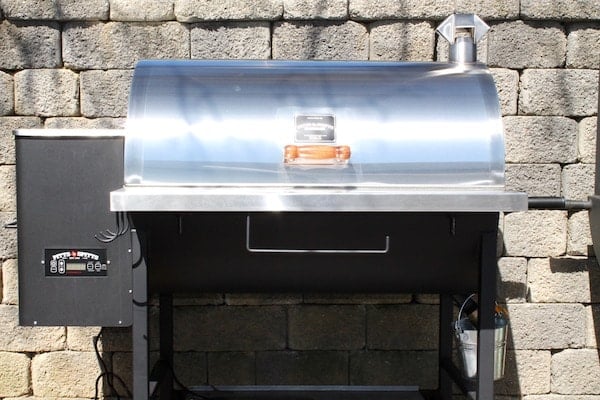
The Pitts & Spitts Maverick 1250 pellet grill is their most popular mid-size model and rivals the best thermostatically controlled cookers in the business. For years, I have been using a Pitts & Spitts offset stickburner (the Ultimate Upright Smoker Pit, 36 inch), so I was eager to test their set-it-and-forget-it pellet version. I was not disappointed, although all cookers have their little quirks, and Pitts & Spitts is no different.
Beautiful workmanship
The company prides itself on making the “best looking, best cooking” smokers and grills. That’s not a bad synopsis of the Maverick’s top traits: nice curves and heavy duty construction. No cheap pop rivets here. The hopper, firepot, and locking caster wheels are bolted on strong and the rest of the cooker is welded tight with thick heavy-gauge steel. There’s 275 pounds worth of metal here, and the larger Maverick, model 2000, weighs 325 pounds. Solid as a rock.
Let’s get some of the beauty marks out of the way. Most pellet smokers have a somewhat square shape. Maybe you prefer that look, but I love the Maverick’s more traditional barrel shape. Plus, a round cooking chamber circulates heat, air and smoke more efficiently than a square one. Even Maverick’s pellet hopper has rounded corners, a purely aesthetic touch, but it makes the cooker more attractive as a whole.
The roll top lid is a Pitts & Spitts signature, and it opens effortlessly even with one finger. Constructed of shiny 304 marine grade stainless steel, the lid has a comfortable red cedar wood handle. The front work table uses the same steel, and the lid rolls back smoothly without knocking anything off the table so you can leave your tools, food, or beer there while opening and closing the cooker. Even the smokestack and pellet hopper lid are made of stainless, giving the whole smoker a cool silver and black look.
Note that the smokestack does stick up from the lid about 4 inches, so when you roll back the lid, the smokestack also rolls back. That means the smokestack can hit a back wall. You have to position the cooker about half a foot away from any patio walls or high railings to open the lid without damaging the smokestack. Not a big deal, but it’s something to be aware of. Other useful touches: a paper towel rack and 3 large tool hooks are welded to the work table, and there’s a large storage shelf beneath the barrel at the bottom of the cooker’s frame.
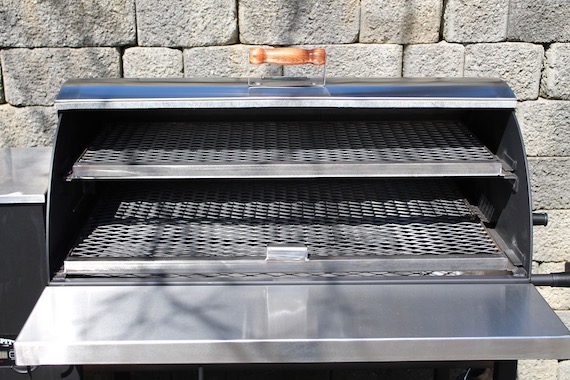

Heavy duty construction
The Maverick 1250 I tested has a carbon steel cooking chamber. They also offer a completely stainless steel version that is way more expensive. But you’ll never have to worry about rust! Either way, the cooking barrel is made of 7 gauge steel, which is thicker than what you find on most pellet cookers (for instance, the cooking chamber of the Yoder YS640, another premium pellet grill, is made of slightly thinner 10 gauge steel). That gauge matters. Thicker steel retains heat better, delivers more heat, and recovers heat better, giving the smoker an edge at maintaining a steady temperature throughout the cooking. Better heat retention also means better efficiency because you’re using less fuel.
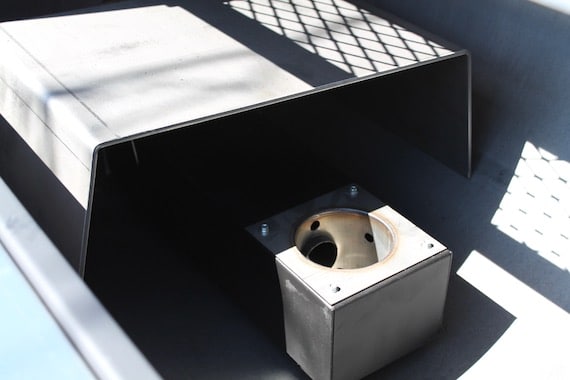
Pitts & Spitts doesn’t cut corners on other parts, either. The deflector plate over the firepot is made of 7 gauge steel. The drip pan is 10 gauge, and the work table, smokestack and various parts are constructed with solid steel as well. All those steel parts to help spread and maintain the heat very evenly throughout the smoker. Overall, you’re looking at 7 and 10 gauge steel in this cooker, compared to slightly thinner 10, 14 or 16 gauge steel in other premium pellet grills. The Maverick is built like a tank.
The heavy deflector plate separates the fuel from the grease. And the drip pan over the deflector plate sits on an angle, directing drippings to a nice big grease chamber on the right. You actuate grease cleanout with a brass ball valve, another nice touch that allows you to open the valve as much or as little as you like for precise control of the airflow, and the grease flow.
Two cooking grates rest on welded rails and slide out easily for a total cooking area of 1250 square inches (the larger Maverick 2000 has 3 cooking grates). I’m not crazy about expanded metal grates for cooking. I prefer cooking on steel rods. But the diamond grates are okay and pretty standard on heavy duty smokers like this one. It’s just takes a little more elbow grease to get them clean.
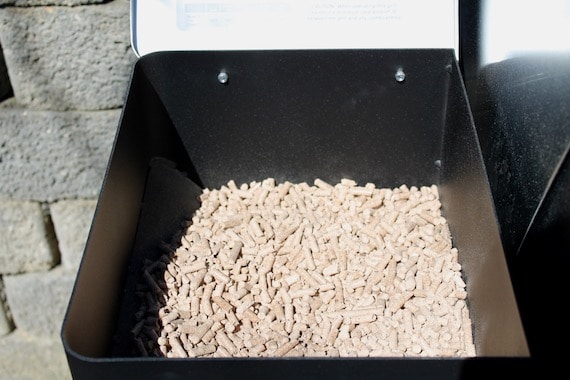
Ground control
The Maverick functions like other pellet smokers: you load up the hopper with wood pellets, an electric motor turns an auger that feeds pellets into the firepot, where a hot rod ignites the pellets and a fan blows oxygen to keep the wood smoldering. A thermostat maintains steady temperature in the cooker, similar to how home ovens work.
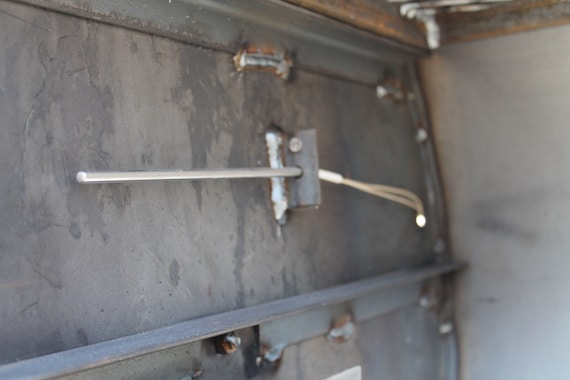
Temperature control on the Maverick happens with two devices: an RTD probe and a digital PID controller. The RTD probe, or “resistance temperature detector,” is essentially a high-tech thermometer that’s more accurate (and more expensive) than thermocouples and other temperature sensors. The RTD helps deliver an accurate temperature reading to the digital PID controller, which stands for “Proportional, Integral, Derivative.” Together, they create a sophisticated thermostat. This is the real brains of the operation. A constant, complex feedback loop of data between the RTD and PID is what allows you to smoke a brisket for 12 hours by just setting a couple target temps and walking away. The RTD feeds accurate temps to the PID, and the PID tells the augur and fan when and when not to feed in more fuel and/or oxygen to maintain a precise temperature throughout the entire cook. This cooker maintains a steady temp to within 5ºF of your set temperature. That’s more precise than the thermostats on most home ovens. Not all pellet cookers have such finely tuned thermostats, but this RTD/PID combo and its heavy-duty construction give the Maverick very stable temps.
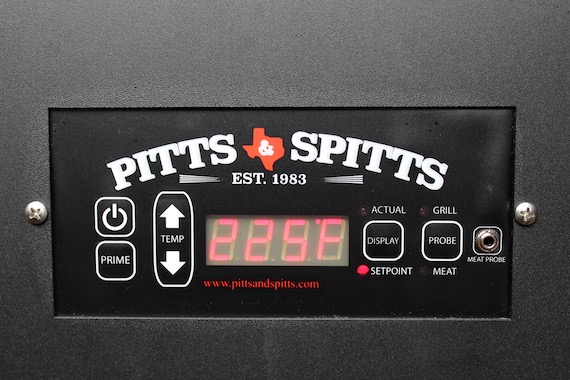
You can set this custom made digital controller in 5ºF increments from a low of 180ºF all the way up to 600ºF. When I first fired it up, the fan cycled on and the cooker temp went to 225ºF in 2 minutes (with the lid down). The fan actually cycled off at about 200ºF and then on and off to slowly reach 225ºF without overshooting the mark, which gives you an idea of how finely tuned the controller is. I clipped a ThermoWorks Smoke thermometer to the center of the grill and temps were consistently within 5ºF of the controller readings. When you open the lid, add cold food, or the weather changes outside, heat recovery is rapid. The fan cycles on and off as necessary—and very frequently—to maintain temp. That constant cycling also produces more steady smoke throughout the cook. In some pellet cookers, you get a few puffs of smoke every 5 minutes or so when the controller kicks back in, but this is a hardworking PID. You get constant smoke similar to (although a bit lighter than) what you see in a stickburner.
The controller is easy to operate with an on/off button and temperature set controls for both the cooking chamber and the meat (a meat probe is included). Buttons allow you to quickly toggle between the set temp and the actual temp for both the grill and the meat. The controller reacts to both the grill set temp (say, 225ºF) and the meat set temp (say, 203ºF). It adjusts fuel and oxygen to maintain the grill temp until the meat comes within 5ºF of the meat set temp. Once the meat set temp is reached, the controller automatically switches the cooker to a temp of 180ºF and the display reads DONE. It essentially puts the finished meat in resting mode. That’s a nice feature if you fall asleep during a long cook. You don’t have to worry about overcooking your brisket. There’s also a safety feature if the controller, for some reason, detects temperatures above 700ºF inside the grill. In that case, the PID automatically shuts down.
To quick start the cooker, you hit the Power button, and then a “Prime” button allows you to manually feed pellets into the firepot. You hold down Prime, and the augur constantly feeds pellets into the firepot and ignites them until you let go. Then the PID operates off the set temps again. Shutdown is simple, too. At the end of a cook, you Power off the smoker, and it runs through a 15-minute shutdown cycle to clear the augur and firepot of pellets so they don’t get wet and cause a jam on your next cook.
All in all, it’s an efficient, intelligent, and user friendly system. And if you’re a real tech head, the company sells the exact same PID in a WiFi enabled version for $299, so you can work all the controls remotely from your cell phone or any other WiFi enabled device.
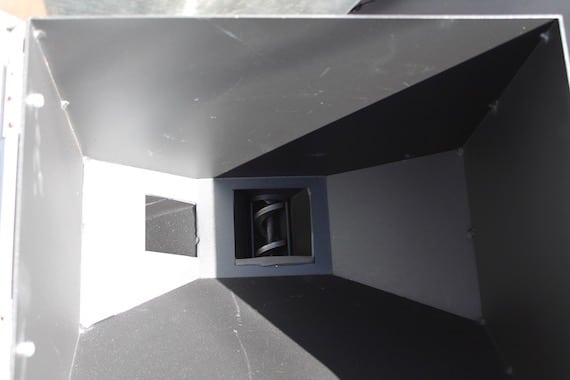
Cook tests
The Maverick’s pellet hopper holds 35 pounds, which is a bit larger than most (for example, the Yoder YS640 holds 20 pounds). A standard bag of pellets is 24 pounds, so you can empty in almost 1 1/2 bags for super long cooks. And if you dump in too many, the hopper has a pellet clean out chute, a little trap door on a chain that lets you empty the hopper or change to different wood pellets between cooks.
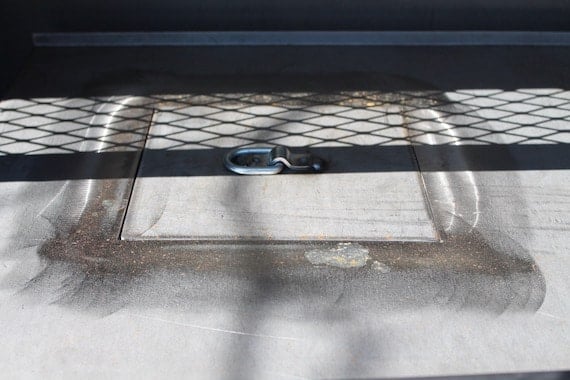
Pitts & Spitts claims you can grill on this cooker, but like many other pellet smokers, the firepot is only 4 inches round. It gets plenty hot right at that spot, and the thick steel deflector plate and drip pan spread out the heat nicely, but superhot searing capability is still limited to a relatively small area. It’s a bit of work to, say, caramelize the glaze on a rack of ribs. You can sear a steak or a few burgers pretty easily, and if you plan on searing often, the company sells a special version of the drip pan with a square Trapdoor for $149. To use it, you move the deflector plate to expose the firepot, then open the 8 inch square Trapdoor by lifting up by the U-shaped shackle. The Trapdoor opening does allow you to get searing temps upwards of 500ºF, but it’s still a small searing area. Putting a cast iron pan or Grill Grates over the trap door gives you a little more room to sear.
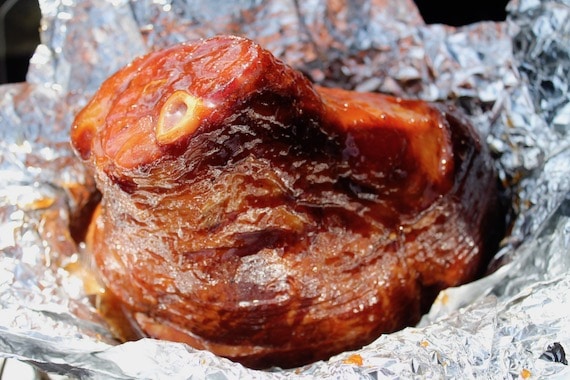
My first cook on the Maverick was the Ultimate Smoked Ham for Easter. Figured I’d start simple, and I had zero problems. I used oak pellets, and the ham came out smoky, slightly sweet and absolutely delicious. The short cook time and steady temps gave me more time to spend with my family during the holiday.
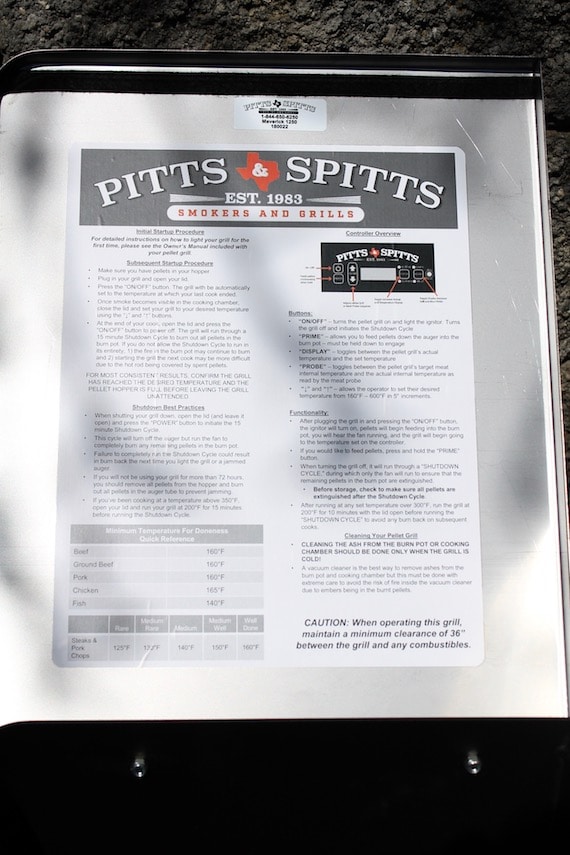
Since it was my first cook, I’m glad the instructions were printed inside the hopper lid: a good reminder of startup, shutdown and fine tuning the controls right there at the smoker.
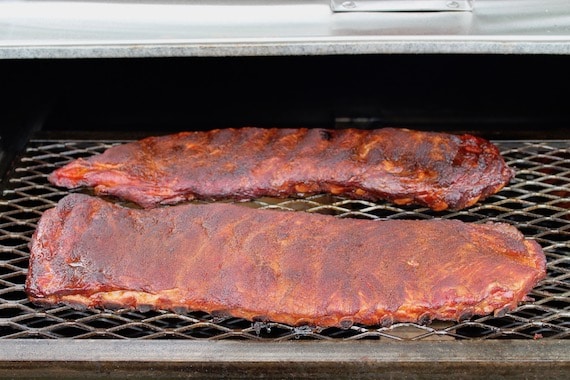
Next up was Last Meal Ribs for Memorial Day. I used Chef Salt Bacon BBQ as the rub. It’s similar to Meathead’s Memphis Dust but with smoked ingredients: smoked paprika, smoked black pepper, smoked salt, and smoky chipotle chile for kick. I always make ribs for Memorial Day and I like to make them extra smoky. My dad loved a smoky rack of ribs like they were the holy grail of outdoor cooking. After he passed away many years ago, I started making ribs every Memorial Day in his honor (he was a Vietnam War vet). To this day, I share those smoky ribs with his grandsons because he didn’t get to spend nearly enough time with them. A water pan and plenty of air circulation in the cooker helped the smoke penetrate deep into the bark. I painted them with chipotle bourbon barbecue sauce then tested the grill’s searing capability. First I bumped the temp up to 500ºF, and then removed the Trapdoor and got to work. It took a few minutes to get them evenly glazed from edge to edge over the small searing area, but it worked and was much easier than transferring the ribs to another grill to do the searing. They came our perfect: juicy, spicy, smoky, tender enough to pull off the bones with your teeth, and sauced just enough to paint your mouth with barbecue lipstick. The kids loved them.
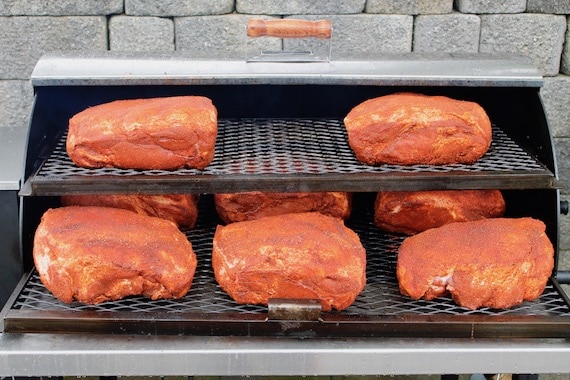
The next cook was all about volume. How would the cooker hold up loaded to the gills with 75 pounds of meat? Every year my band, Tavern Tan, headlines a blues, brews and BBQ show at our local club Godfrey Daniel’s. We supply all the food, which is included in the ticket price. I loaded the Maverick with 8 seasoned pork butts for Pulled Pork sandwiches. Again, I used Chef Salt Bacon BBQ for the rub because I love the stuff. And truth be told, the smoke on a pellet grill is a little more delicate that what you get burning logs. It’s cleaner smoke and better tasting in my opinion, but it is slightly less intense and less bitter. So I like to goose up the smoke with smoked seasonings like chipotle, smoked salt and smoked paprika. The Maverick handled all 8 pork butts like a champ. I decided not to fuss with the meat during the cook: I monitored the internal temp as it rose, but I didn’t open the lid to check the butts or move them around. The shoulders closest to the burn pot finished first, but not by much, which shows you how good the heat distribution is. I simply removed and pulled those butts first, while the remaining ones got up to temp.
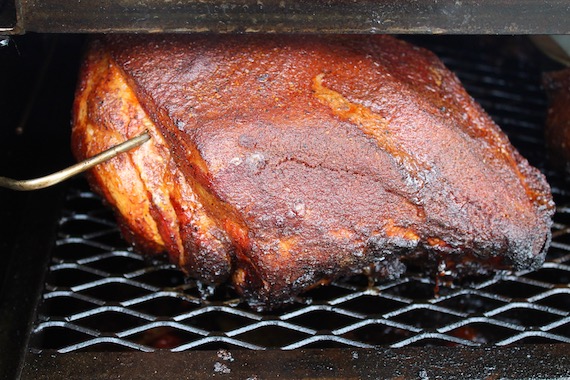
There was one snafu during this cook. I ran out of pellets. Well, actually there were plenty of pellets in the hopper, but they didn’t all funnel down to the augur, so the cooker temp dropped below 225ºF. Not a big deal. I just pushed the pellets down from the sides of the hopper and loaded in more (oak and apple). Word to the wise: check your pellet level now and then.
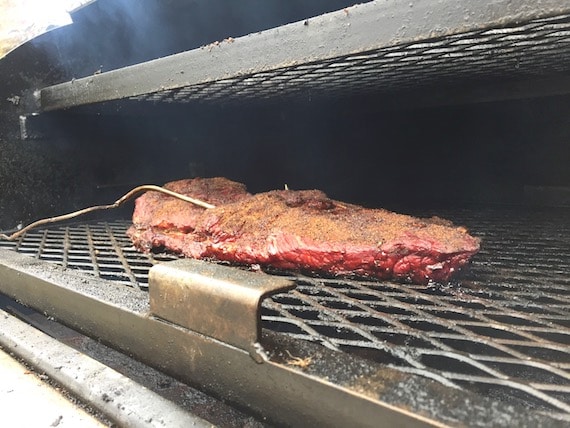
Now for my holy grail: Ultimate Brisket. Nailing this cook takes practice, but a pellet grill promises to make it easier. I started at midnight on a Thursday in the fall so I could serve the brisket later the next day. I loaded in a 25 pound mix of mesquite, oak and pecan pellets, plenty to last overnight. I set the cooker temp to 225ºF, the meat doneness temp to 203ºF, and laid the injected, dry brined, spice rubbed packer brisket on the grate. Then I went to bed. With dreams of burnt ends dancing in my head. In the morning, I grabbed coffee, and checked everything. At 8am, the meat’s internal temp was at 144ºF. Good progress. By 10am, the bark was dark red, and the internal temp was at 154ºF, entering the stall. The Maverick had burned 6 pounds of pellets in those 10 hours, which averages out to a little more than 1/2 pound per hour. That’s pretty efficient, considering it was a chilly 40ºF overnight that night. I crutched the brisket and transferred it to my indoor oven at 225ºF. Why waste the pellets if the actual smoking was done? Four hours later, the meat got up to 203ºF and looked fantastic. I put it in a faux Cambro for 4 hours, and served it at 6pm for dinner. It sliced beautifully. Soft. Juicy. Peppery. Succulent. And the smoke ring was 1/2 inch thick. That’s a bit a deeper than I’m used to, maybe owing to the water pan I threw in the cooker for shits and giggles. A water pan really isn’t necessary in a pellet grill because there’s plenty of humidity and air circulation in there, but that smoke ring was killer.
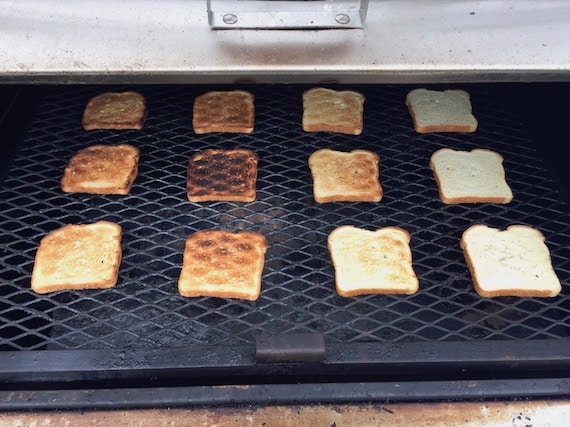
Since then, I’ve done several other low and slow cooks, and in all of them, heat distribution has been very even. I haven’t had to move racks of ribs or pork butts around too much for even cooking. But I wanted to see how even the distribution was at higher heats. To find out, I cranked the PID to its max, 600ºF, with the deflector plate and drip pan in place. Then I did the bread test. As you can see, at high temps, the Maverick is hotter in the center and left where the firepot and auger assembly are located, which makes sense. Otherwise, at typical low smoking temps, this cooker delivers good heat distribution thanks to its thick steel.
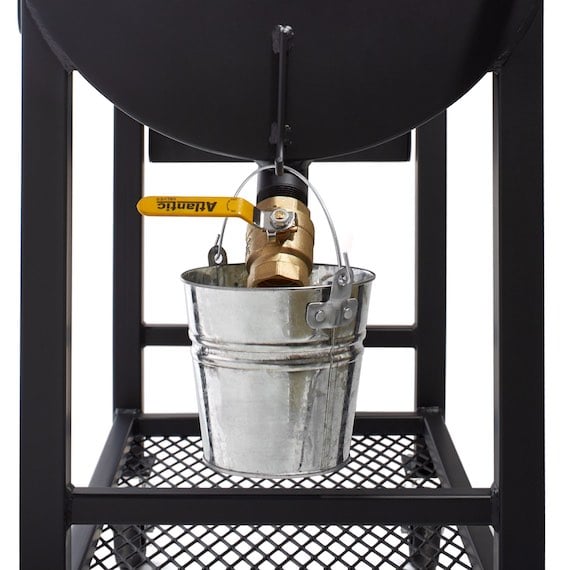
Cleanup
Cleaning the Maverick is similar to other pellet grills. The drip pan is angled into the grease trap, which is separated from the rest of the cooking chamber by a welded steel half wall. Scrape gunk from both the grates and the drip pan into the grease trap, then open the brass ball valve, and your grease drains away into a bucket. You can also cover the drip pan with foil for easier cleanup. If you go for the Trapdoor option, keep in mind that some stray grease drips through the door and ends up on the bottom of the cooking chamber near the firepot. No big deal. I just let it solidify and scraped it from the bottom of the barrel with a spackle knife. You can even scrape under the firepot assembly to make sure the cooking chamber stays nice and clean and doesn’t produce any off flavors in your cooks.
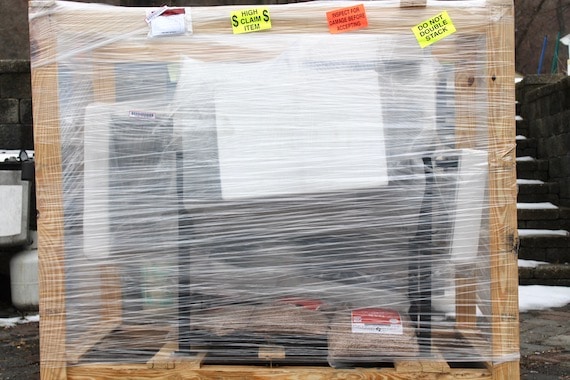
Assembly
How hard is it to put together this heavy-duty smoker? Not very. The Maverick arrived bolted to a shipping pallet and wood frame constructed by the manufacturer. Under the shipping wrap, all the edges were protected with thick styrofoam buffers. The packaging was very solid and there was no damage during shipping. Assembly consists of bolting on the wheels and attaching the work shelf. Place the deflector plate and drip pan in place, and you’re ready to fire up. For the initial startup procedure, you run it empty at 375ºF for 30 minutes and spray it with oil to season the interior like you would a cast-iron pan. Once that’s done, you never have to do it again.
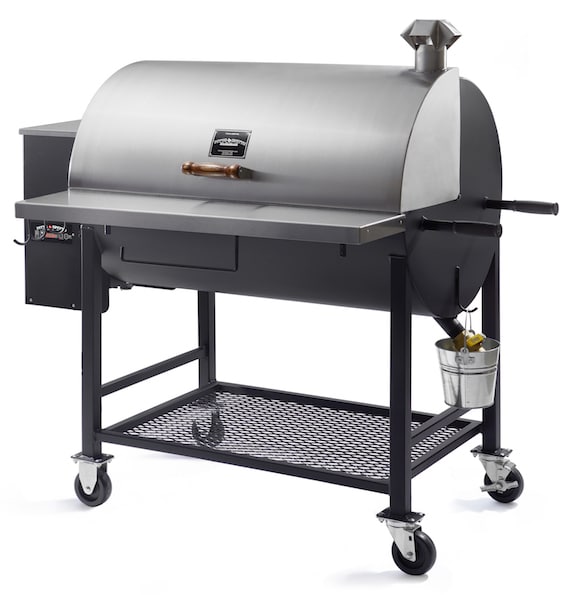
Conclusion
After 8 months of cooking on this thing, I’m pretty impressed. I would highly recommend this smoker to anyone who wants a reliable, tight, well constructed, low maintenance, good looking pellet grill. Combustion is excellent and the cooker maintains steady temps and consistent smoke. The smoke isn’t heavy but it’s not exactly light either. You can taste it. If you prefer heavier stickburner smoke, you can always lay some wood over the firepot area for a little extra burn.
A few nits to pick: The storage shelf under the cooking barrel is ample, but it’s not covered and does get wet in windy, rainy weather. If you live in a rainy area, you’ll need to store your pellets in a dry place somewhere else.
Also, after several months in rain, sun, wind and other severe weather, the felt strip on the lid (which helps create a tight seal and keeps the lid from clunking down on the work table) lost its stickum and fell off. Seems that the felt got wet and the glue dissolved. No big deal. I easily re-stuck it with some Gorilla Glue, and it’s been stuck on ever since. Thankfully the felt on the pellet hopper lid (another nice touch to avoid banging sounds) has stayed put.
Oh, and the pellet cleanout door got stuck after several months in crappy weather. It’s just a thin little door that slides up and down like a window. To un-stick it, I applied some elbow grease, then applied some actual grease. I’ve had no problems since then.
Pitts & Spitts has been making barrel shaped offset smokers in Houston, Texas since 1983, and they have a solid reputation in the business. They use American steel, and several award-winning barbecue competition teams swear by their cookers. The Maverick, their relatively new entry into the pellet grill market, seems poised for similar success.
Warranty
10 years on the barrel, 3 years on the PID controller, and 1 year on other parts.
We thank Pitts & Spitts for providing a Maverick 1250 for our review.
Click the buttons below to search our complete database of reviews:
Product Information:
-
Model:Pitts & Spitts Maverick 1250 pellet grill
-
Item Price :2,199.00
*Price Subject To Change -
Where to buy (buying from this supplier supports this website):
-
Review Method:Cooked On It
We have hands-on experience testing this product. We have also gathered info from the manufacturer, owners and other reliable sources. -
Primary Function:Smoker
-
Fuel:Wood Pellets
-
Main Burners:1
-
Primary Capacity:Large (about 61 burgers) : 1250 square inches
Manufacturer:
-
Pitts & Spitts

Pitts & Spitts in Houston, TX makes a variety of grills and smokers from big residential models to really big trailer mounted commercial and competition systems. The big rigs can be heavily customized with unique features and colorful styling.
Related reviews
-
Dave Joachim, AmazingRibs.com Editorial Director - Editorial Director of AmazingRibs.com, David Joachim has authored, edited, or collaborated on more than 50 cookbooks, four of them on barbecue and grilling, and his Food Science column appeared in "Fine Cooking" magazine from 2011 to 2019. He’s a perfect match for a website dedicated to the “Science of Barbecue and Grilling.”
Up Your BBQ IQ By Joining The Pitmaster Club

Sign up for a free trial of the AmazingRibs.com Pitmaster Club and experience everything that the world’s largest membership-based BBQ and grilling community has to offer!

High quality websites are expensive to run. If you help us, we’ll pay you back bigtime with an ad-free experience and a lot of freebies!
Millions come to AmazingRibs.com every month for high quality tested recipes, tips on technique, science, mythbusting, product reviews, and inspiration. But it is expensive to run a website with more than 2,000 pages and we don’t have a big corporate partner to subsidize us.
Our most important source of sustenance is people who join our Pitmaster Club. But please don’t think of it as a donation. Members get MANY great benefits. We block all third-party ads, we give members free ebooks, magazines, interviews, webinars, more recipes, a monthly sweepstakes with prizes worth up to $2,000, discounts on products, and best of all a community of like-minded cooks free of flame wars. Click below to see all the benefits, take a free 30 day trial, and help keep this site alive.
Post comments and questions below
1) Please try the search box at the top of every page before you ask for help.
2) Try to post your question to the appropriate page.
3) Tell us everything we need to know to help such as the type of cooker and thermometer. Dial thermometers are often off by as much as 50°F so if you are not using a good digital thermometer we probably can’t help you with time and temp questions. Please read this article about thermometers.
4) If you are a member of the Pitmaster Club, your comments login is probably different.
5) Posts with links in them may not appear immediately.
Moderators